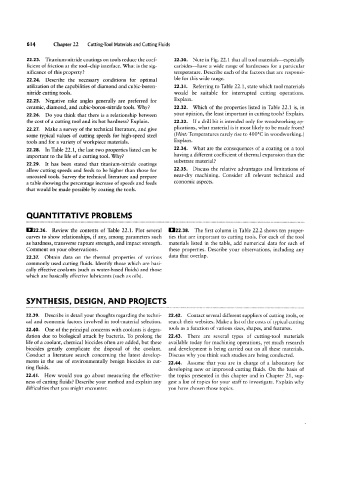Page 633 - 04. Subyek Engineering Materials - Manufacturing, Engineering and Technology SI 6th Edition - Serope Kalpakjian, Stephen Schmid (2009)
P. 633
6|4 Chapter 22 Cutting-Tool Materials and Cutting Fluids
22.23. Titanium-nitride coatings on tools reduce the coef- 22.30. Note in Fig. 22.1 that all tool materials-especially
ficient of friction at the tool-chip interface. What is the sig- carbides-have a wide range of hardnesses for a particular
nificance of this property? temperature. Describe each of the factors that are responsi-
22.24. Describe the necessary conditions for optimal ble for this wide range.
utilization of the capabilities of diamond and cubic-boron- 22.31. Referring to Table 22.1, state which tool materials
nitride cutting tools. would be suitable for interrupted cutting operations.
22.25. Negative rake angles generally are preferred for Explain.
ceramic, diamond, and cubic-boron-nitride tools. Why? 22.32. Which of the properties listed in Table 22.1 is, in
22.26. Do you think that there is a relationship between your opinion, the least important in cutting tools? Explain.
the cost of a cutting tool and its hot hardness? Explain. 22.33. If a drill bit is intended only for woodworking ap-
22.27. Make a survey of the technical literature, and give plications, what material is it most likely to be made from?
(Hint: Temperatures rarely rise to 400°C in woodworking.)
some typical values of cutting speeds for high-speed steel
tools and for a variety of workpiece materials. Explain.
22.28. In Table 22.1, the last two properties listed can be 22.34. What are the consequences of a coating on a tool
important to the life of a cutting tool. Why? having a different coefficient of thermal expansion than the
substrate material?
22.29. It has been stated that titanium-nitride coatings
allow cutting speeds and feeds to be higher than those for 22.35. Discuss the relative advantages and limitations of
uncoated tools. Survey the technical literature and prepare near-dry machining. Consider all relevant technical and
a table showing the percentage increase of speeds and feeds economic aspects.
that would be made possible by coating the tools.
QUANTITATIVE PROBLEMS
|]22.36. Review the contents of Table 22.1. Plot several |]22.38. The first column in Table 22.2 shows ten proper-
curves to show relationships, if any, among parameters such ties that are important to cutting tools. For each of the tool
as hardness, transverse rupture strength, and impact strength. materials listed in the table, add numerical data for each of
Comment on your observations. these properties. Describe your observations, including any
22.37. Obtain data on the thermal properties of various data that overlap.
commonly used cutting fluids. Identify those which are basi-
cally effective coolants (such as water-based fluids) and those
which are basically effective lubricants (such as oils).
SYNTHESIS, DESIGN, AND PROIECTS
22.39. Describe in detail your thoughts regarding the techni- 22.42. Contact several different suppliers of cutting tools, or
cal and economic factors involved in tool-material selection. search their websites. Make a list of the costs of typical cutting
22.40. One of the principal concerns with coolants is degra- tools as a function of various sizes, shapes, and features.
dation due to biological attack by bacteria. To prolong the 22.43. There are several types of cutting-tool materials
life of a coolant, chemical biocides often are added, but these available today for machining operations, yet much research
biocides greatly complicate the disposal of the coolant. and development is being carried out on all these materials.
Conduct a literature search concerning the latest develop- Discuss why you think such studies are being conducted.
ments in the use of environmentally benign biocides in cut- 22.44. Assume that you are in charge of a laboratory for
ting fluids. developing new or improved cutting fluids. Un the basis of
22.4|. How would you go about measuring the effective- the topics presented in this chapter and in Chapter 21, sug-
ness of cutting fluids? Describe your method and explain any gest a list of topics for your staff to investigate. Explain why
difficulties that you might encounter. you have chosen those topics.

